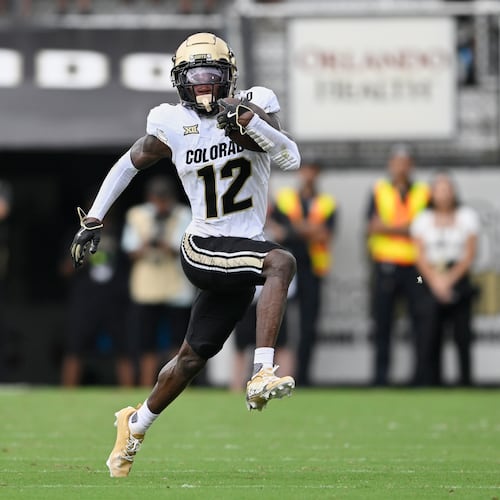In the famous “Chicks Dig The Long Ball” Nike commercial, Tom Glavine and Greg Maddux played to what was widely seen as nerdy type. “We got Cy Young winners over here!” Maddux whined to the worshipers (Heather Locklear chief among them) swooning over the sight of Mark McGwire taking batting practice. The scrawny pitchers tried to bulk up. Then, presumably buff, they were abashed when Ms. Locklear asked them, “Have you guys seen Mark?”
For Maddux and Glavine, this scripted bit served to embellish their curious place in baseball legend. They were around when journeymen started hitting 50 homers in a season. (For a snippet of time, these were known as baseball’s glory days. They’re now ruefully recalled as The Steroids Era. Sic transit gloria.) These pitchers of modest size didn’t hit the ball long distances. Heck, they didn’t even throw hard. What were they doing in a real man’s sport, anyway?
Only dominating it.
Six Cy Youngs between them. Six hundred sixty victories between them. As a tandem they powered the Braves to nine of the never-to-be-matched 14 consecutive division titles, and one or the other had a hand in three of the remaining five. Other splendid pitchers were part of the great run — the Hall-of-Famer-to-be John Smoltz being the best of those, with massive contributions also coming from Steve Avery and Charlie Leibrandt and Kevin Millwood — but these two nerds became the tent poles of a rotation now regarded as the best there ever was.
OK, so they weren’t really nerdy. Glavine was drafted by the Los Angeles Kings as a hockey player; Maddux was so nimble he won 18 Gold Gloves. But the radar gun, which for no real reason is deemed a measure of pitching excellence, didn’t love or even like them, and no batter ever trembled at the thought of facing Maddux or Glavine. They knew they wouldn’t take a golden sombrero and strike out four times. (Instead they’d go 0-for-4 with three groundouts to second base.)
The weird part was that both Glavine and Maddux pitched off their fastballs, modest though they were. They made the absence of velocity the baseball equivalent of jiu-jitsu. As Maddux once told me: “You stand in the middle of the road and a car’s coming at you. Can you tell how fast it’s going? Can you tell if it’s going 55 or 60? You can’t. It’s the same standing in the middle of the diamond trying to hit a baseball. As a pitcher, you’re better off making 75 [mph] look like 85 instead of making 87 look like 90.”
Playing around in the outfield during spring training, Glavine discovered the grip for the circle change that would elevate him from promising pitcher to 20-game winner. Maddux really didn’t need much beyond his fastball and its offshoot, the cutter. They took fierce pride — nicknamed Mad Dog, Maddux was famous for staring down hitters — in doing more with what seemed rather less. They didn’t throw nearly as hard as Randy Johnson, who was known as the Big Unit and of whom Maddux admiringly said, “His slider is faster than my fastball.” But that, for opponents, only ramped up the Indignation Index. If these guys are throwing 89 mph, why we can’t hit them?
“The word that’s ruining baseball today is ‘velocity,’” said Leo Mazzone, the Braves’ pitching coach for every year of the Maddux/Glavine partnership. “I never used that word. We worked with what guys could do.”
The idiosyncratic Mazzone was the ideal steward for two pitchers not cut from standard cloth. He didn’t care how the job got done; he worried only about his guys staying healthy enough to do it. With their worry-free deliveries and their ability to win without overthrowing, Maddux and Glavine never got hurt. Doesn’t matter how hard you can throw if your arm’s in a sling.
To this day, Mazzone insists Glavine and Maddux “had above-average major-league fastballs,” even if the radar gun suggested otherwise. But Mazzone, as noted, cared nothing radar readings. “Their fastballs had movement and they had life,” he said. Best of all, their fastballs worked.
The apotheosis of this came in the 1995 World Series. The Cleveland Indians entered having hit .291 as a team and were staffed by stalwarts Albert Belle, Manny Ramirez, Eddie Murray, Jim Thome, Carlos Baerga and Kenny Lofton. They managed two hits off Maddux in Game 1, three hits off Glavine in Game 2 and one hit off Glavine in the clinching Game 6. The brawny Tribe swung big and accomplished nothing.
Two years earlier, Glavine beat Philadelphia in Game 3 of the NLCS. Six days before that, he’d beaten Colorado for the Braves’ 104th victory of the regular season, a victory that would ultimately leave them one game in front of the San Francisco Giants in the last great pennant race. Glavine spoke after the playoff victory of his soft-toss image, saying: “People aren’t going to watch me pitch and walk away in awe. But more times than not I’m going to give my team a chance to win.”
The fourth inning of that NLCS game was a case study in damage control, a Glavine staple: With the Phillies leading 1-0 and John Kruk at third and nobody out, Glavine induced Dave Hollins to ground to short on a 2-1 change-up, Darren Daulton to bounce to the mound on a 2-1 slider (Glavine’s third-best pitch) and Pete Incaviglia to fly to center on a 1-1 fastball. Kruk didn’t score. Those were great pitches against good hitters in a pressurized setting, and they recalled another inning in August that year.
Trailing the Giants by 7 1/2 games with 37 to play, the Braves went to Candlestick Park for a series starting Aug. 23. Avery won the first. Glavine worked the second game, and come the third inning the Giants, trailing 1-0, loaded the bases with three one-out singles. Due up: Will Clark, Barry Bonds and Matt Williams. Bonds and Williams wouldn’t bat until the fourth inning. The sweet-swinging Clark grounded into a double play.
Glavine won that day. Maddux would win the next day to complete the sweep. The Braves were within 4 1/2 games. Much later, this correspondent asked: The pitch to Clark, the biggest pitch of the last great pennant race — what was it?
“A fastball,” Glavine said.
Oh, I said. The ol’ lukewarm Glavine 81-mph heater?
“Eighty-two,” he said, playing along. “With movement.”
To watch Sandy Koufax and the Big Unit back in the day and to behold Clayton Kershaw and Felix Hernandez now is to appreciate a great pitcher with great stuff. To have seen Maddux and Glavine was to see pitching rise to the level of greatness on the wings of stubbornness and smarts. When managing the Houston Astros, the former pitcher Larry Dierker drew this subtle distinction: “Maddux would rather give you something to hit than walk you; Glavine would rather walk you than give you something to hit.”
Said Mazzone: “Maddux’s approach was to take you out immediately; Glavine’s was to never give in. Other managers would come up to me and say, ‘We know exactly where Glavine’s going to be, but we can’t do anything about it.’ And Maddux just had the best control ever.”
Maddux was legendary in-house for seeing things others could not. From Mark Lemke, then the second baseman: “He’d call me over and say, ‘Move to your left two pitches from now.’ Not on the next pitch, but the pitch after that. He said, ‘I’m going to throw something he’ll foul off, and then I’m going to throw him a slider he’ll ground into the hole.’”
From Terry Pendleton, then the third baseman: “We were in Cincinnati one night and Bret Boone kept fouling off fastballs, and I went to the mound and said, ‘You could get him with a slider.’ And Doggie said, ‘Yeah, but I want to save that for when runners are in scoring position.’”
From Mazzone: ‘We were having our pitchers’ meeting before the 1996 World Series and we were going over the scouting report. It said to pitch Bernie Williams a certain way. Maddux said, ‘That’s not right. I’ve watched every game they’ve played the last two weeks and he’s killing that pitch.’ And I said, ‘We’ll go with Doggie on this one.’” (Williams faced Maddux three times in Game 2. He went 0-for-3.)
Bobby Cox, the manager who’ll be enshrined in the Hall of Fame alongside Maddux and Glavine, tells a lengthy story about Maddux asking before a game for two pitches to try against a certain hitter before working around him — but only if it was in the fifth inning. Turned out that the hitter didn’t bat until the sixth, whereupon Cox went to the mound and asked: “Is this where you want the two pitches?”
Maddux, slightly irked: “Don’t you remember?”
Cox: “Mad Dog, what are you trying to do?”
Maddux: “I’m going to get him to pop up in foul territory outside third base.”
Cox: “Go ahead and try — even though he’s hit 50 home runs and he’s hitting .450 off you.”
Cox returned to the dugout. Mazzone asked, “Aren’t we going to walk him?”
Said Cox: “No, we’re going to make him pop up in foul territory outside third base.”
On cue, the big bopper popped up in foul territory outside third base. The kicker here is that Maddux, more than a decade later, couldn’t remember who the guy was. (Cox did. It was Luis Gonzalez.) Mad Dog saw only what he needed to see.
As a pairing, there’d never been one like Glavine and Maddux — two 300-game winners, neither a strikeout king — and with the ever-increasing emphasis on power pitching, there won’t be another. (Said Mazzone: “The Dodgers have Kershaw and (Zack) Greinke, but they’ve got great stuff.”) Mad Dog and the Glavinator were the chess club hunkering down on the mats and outwrestling the macho men. Theirs was the revenge of the nerds.
About the Author
Keep Reading
The Latest
Featured

